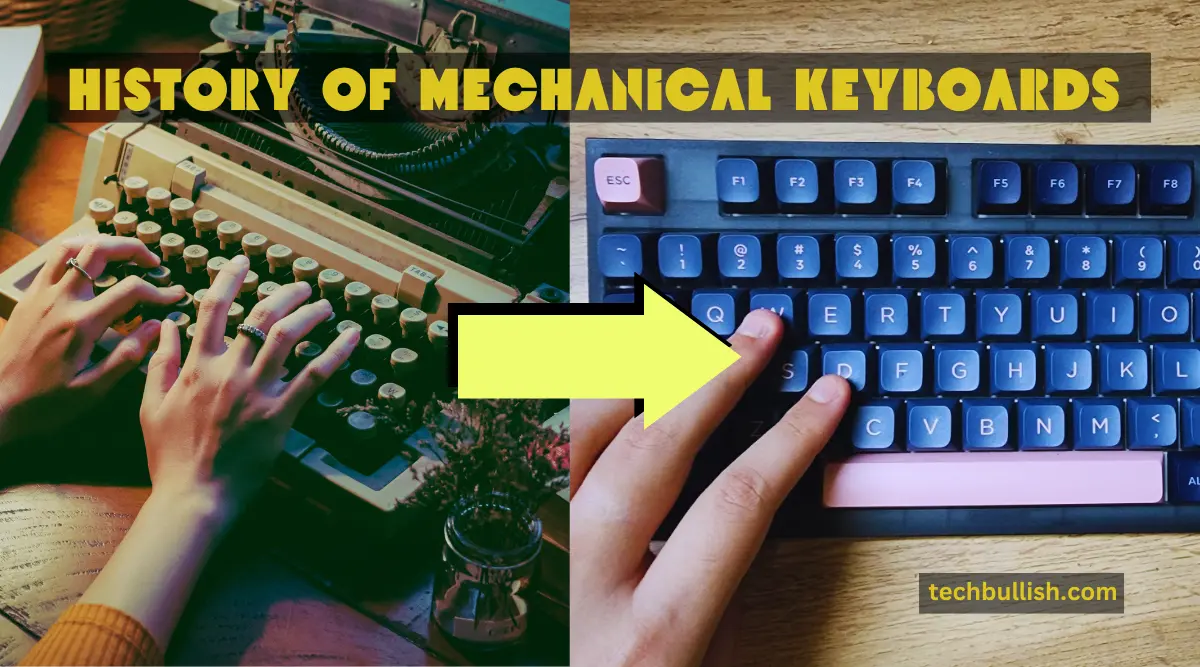From Typewriters to Computer Keyboards and then to Mechanical Keyboards evolution took time and has an interesting history to discuss.
If you are a mechanical keyboard enthusiast, this post is going to be one of the most interesting ones to read. I have done intense research, before writing this post.

Let’s get started!
When did mechanical keyboards first come out?
Typing technology was initiated centuries before the evolution of computers to ease human efforts.
The first ever typing device got its place in 1700 with its design and prospects although it was in the 1870s that saw the manufacturing of the first typing device.
The period between 1830-1870, witnessed the advancement of plans to furnish typing machines as a commercial product.
The drastic change defining typing forever came with the collaboration between Sholes (an inventor and technologist), Glidden (a mechanic), and Soule (a printer).
The invention was a typewriter model which looked like a sewing machine. Following the changes, a slight desktop version of the typewriter was the standard design until IBM Selectric was introduced in 1961.
Another fascination that caught people’s attention was the emergence of computers in 1946 with the first computer ENIAC. However, it was space-consuming for its massive size. In the late 1970s computers with VOT and electrical keyboards were gaining popularity.
Ultimately in 1986, IBM released its PC equipped with the Model M keyboard. The Model M keyboard was a mechanical keyboard. It came with elite qualities of construction leading the typist with its tactile feedback, accuracy, and comfort.
The mechanical keyboards with their exclusive feature of each key having its own key switch and spring gained immediate popularity in the consumer market.
It was a raging innovation compared to the standard keyboards that had a single rubber membrane underneath all of the keys to avoid noise.
The anatomical variety, fueling resistance, and sound of the keys made the mechanical keyboard extremely user-friendly.
History of Mechanical Keyboards
Mechanical keyboards find their existence deeply rooted in the concept of the printing press invented around 1439. Centuries of interventional prospects came up with typewriters in the first place. Developed incrementally by numerous independent inventors, the typewriter went through 52 transformations with time.
In 1575 Francesco Rampazzetto invented the Scrittura tattile, the first typewriting device. This device saw its commercial success and was patented in 1867.
The origin of QWERTY keyboards still in use were introduced in the Sholes & Glidden typewriters. Hence it developed a thriving typewriter industry with standardized layouts that were used in computers later.
In 1833, the first mechanical computer was introduced by Charles Babbage. Later in 1836, an electromechanical analog computer was developed by the US Navy.
Throughout 1956 MIT researchers began experimenting to access a direct keyboard input into computers with the evolution of computer keyboards.
By 1976 “Personal Computers” took the central stage of the electronic industry. With their efficient size, capabilities, and price, these multipurpose computers came with a mouse, monitor, and keyboard.
Keyboards became a mandatory computer standard between the late 1970s and early 1980s. Developing and experimenting with different types of keyboard technologies was the ultimate improvising goal. They included Membrane, Chiclet, Ultrasound, and Reed switches.
Popular among these were buckling spring switches with the IBM Model F and IBM Model M keyboards.
By the mid-1980s, a German company launched Cherry MX switches. These were inspirational mechanical switches that seem to be prioritized to date. Packed with reliability, smooth feel, and tactile feedback IBM’s buckle spring switches and Cherry’s mechanical switches are loved by users.
Learn More about the Mechanical switch’s history here.
However, by the 1990s membrane keyboards began floating in the market. They were cheaper to produce and moreover were slimmer and lighter in weight making it preferable for the laptop generation who like it portable.
Punching the qualities of two cherished keyboard types in the market, (membrane keyboards and mechanical keyboards) the Dome-switch keyboards were the new trend that became popular with time.
These were cheaper, lighter, and easy to use in a portable setup. Although with such attractive features, users found Dome switch keyboards mushy rather than satisfying mechanical keyboards. People turned back to looking upon mechanical keyboards for long working hours over computers or PC gaming.
In the mid-2000s computer enthusiasts, gamers and typists took mechanical keyboards for consistency in working. The resurgence of mechanical keyboards with more customizable features, new switches, keycaps, and layouts regained popularity. Other than durability, tactile and audible feedback they became one-of-kind!
Mechanical keyboards were preferred by all who wanted them unique for their keyboards.
Early Years: From Typewriters to Computing
It is known that in 1808 Pellegrino Turri in Italy designed a typing device that allowed the blind to ‘write’. It has featured carbon copy which is used in modern office work to date.
In 1829 William Austin Burt created typewriters that used dials to print characters instead of keys.
Later in 1852 John Jones also created typewriters but none of these received commercial success. In 1861, Father Francisco created a homemade typewriter with wood and knives.
Another attempt to create a typewriter was made by Reverend Rasmus Malling Hansen in 1865. He invented a half-sphere-shaped functional typing device named “Writing Ball”. It was an electrical device. Hansen later created the “Tall Model” in 1875 which worked without electricity.
This attracted consumers from rural and urban places.
In 1867, “The First Typewriter” was created by Sholes, Glidden, and Soule. This was the most successful typing device of that period.
The desktop version of typewriters was finally introduced as IBM Selectric in 1961. This saw an advancement in typing speed and efficiency. It gave the typist more freedom and accessibility with typing.
In the 1870s the first manufactured typing device featured ‘blind typing’ technology, where the characters could be seen once the typing was complete as they were printed upside down.
Over years typewriters evolved as electronics moved on with the invention of computers with keyboards. The first typewriter “Remington” was designed with a foot pedal like a sewing machine. It was not for commercial use though. It was known to be used to prepare legal documents in a standardized format.
However, Selectric Typewriters saw huge popularity until the computer age in the 1980s.In the prevailing conditions computers were considered far more reliable and expert with their popular input device -” The Computer Keyboards”.
With developed organized work patterns computers took over the charm of typewriters which were alongside in due course of time.
Old Computer Keyboards: Membrane Keyboard Dominance
In a membrane keyboard, the keys that activate signals for a device have a thin layer of flexible material that represents the keys. These are mechanical switches controlling electrical connections. These individual keys give commands by producing signals.
They provide commands for robotics and machines which are controlled by computer numerical. Other than inputting data into industrial and commercial devices. These keyboards are also used for typing and gaming purposes.
All keys lie on the topmost layer of a membrane keyboard and are made of plastic or rubber materials. A thin flexible rubber or plastic membrane are pressure pads that lie beneath the keys. They have printed conductive traces on the backside.
A layer separating the pressure pads from the bottommost layer to avoid any mechanical contact when the key is not pressed is called the hole layer. Printed traces connected to the keyboard’s circuit inside the keyboard conductive traces attached to the circuit inside the keyboard when a key is pressed.
A key is assigned to each switch on the circuit. The electric current flows with this mechanical contact. The alphanumeric character or command is registered and the correspondent signal is sent to the processing system of the device.
Membrane keyboards are not limited to the traditional QWERTY layout. They are used in numerous applications with customized flexibility as the user’s choice. They are more portable and lighter than mechanical keyboards.
Multiple keyboards come with multiple layers and designs. They have flat or dome switches.
Some of the most popular membrane keyboards are-
- Membrane Switch Keyboard
- Full Travel Membrane Keyboard
- Dome Switch Membrane Keyboard
- Scissor Switch Keyboard
- Chiclet Keyboard
- Capacitive Keyboard.
Old mechanical keyboards
With the evolution of technology, the upgradation of keyboards is a common factor although classic designs are still cherished by keyboard enthusiasts. Some of the vintage models in keyboards are still looked upon by keyboard fanatics.
These are some popular retro models like:
IBM Model M Keyboard
This “Model M”, popularly known as the IBM Enhanced keyboard is the most influential keyboard of all time. Switches with a unique buckling spring and membrane design with efficient durability make this model extremely popular among users to date.
Azio Retro Classic
Recognized like an old-fashioned typewriter, this steampunk model keyboard performs like a modern mechanical keyboard. Its rounded metal-wrapped keycaps with responsive tactile key switches and a comfortable wrist rest assure the user of a gentle typing experience. This keyboard is elegant and a classic piece.
Fujitsu FKB 4700
Stormy with a durability factor this one is an exclusive retro keyboard. Its heavy-duty construction with resilient plastic case and thick metal back plate makes it unique along with its Peerless switches. Its intriguing switch technology and high-quality board make it prominent as a vintage collection.
Qwerty Writer
It simply falls on the old-school technology designing aspect with volume-controlling roller knobs and a cast metal return bar functioning as an enter button. Its aesthetic all metal construction reminds of a past era.
The Cherry MX Blue switches make typing tactile and audible noticeable other than the return bar adding to a nostalgic experience.
Liberty/Morrow BT 1200A-1
Its beautiful layout and sleek design make this adorable amongst the other vintage models. Extremely stylish with a black case, Slate grey keycaps and thick legend make this keypad model remarkable.
Modern Day Mechanical Keyboards
In a modern-day mechanical keyboard, each of its keys has perfection in typing accuracy. They are widely preferred by typists, programmers & gamers. Keys in mechanical keyboards have plastic switches under them making a thorough connection, unlike rubber.
When you push a key on a mechanical keyboard, the stem attached to the keycap held up by a spring forces the stem to go down making two electrical contacts to touch.
The switches on these keyboards are either tactile or linear, resulting in quick activation with less typing effort.
Overall, a mechanical keyboard helps you to type faster with accuracy and allows gamers to control their in-game movements perfectly.
A special feature for gamers “N Key Rollover”(NKRO) or “Anti ghosting” ensures the exact key press of any key specification, even though keys are pressed simultaneously. Replacement of any damaged key can be easily done with a mechanical keyboard.
Why did mechanical keyboards become popular?
Mechanical keyboards are popular from the game’s perspective as they are more tactile, durable, and faster. These have resistance with added anatomical differences.
Moreover, they provide a more comfortable typing experience than rubber-dome keyboards offering a high level of responsiveness and accuracy.
Conclusion
Let’s conclude the post on the History of Mechanical Keyboards!
Mechanical keyboards are really great and ever since I switched to a mechanical keyboard, I never switched back to a membrane keyboard. Even, I try to use an external mechanical keyboard whenever I use my laptop.
With this detailed walkthrough of the timeline, I hope you enjoyed reading this post and found it useful!

I’m Anirban Saha, Founder & Editor of TechBullish. With a B.Tech in Electronics and Communication Engineering, and 5+ years of experience as a software developer, I have expertise in electronics, software development, gadgets, and computer peripherals. I love sharing my knowledge through informational articles, how-to guides, and troubleshooting tips for Peripherals, Smart TVs, Streaming Solutions, and more here. Check Anirban’s Crunchbase Profile here.
